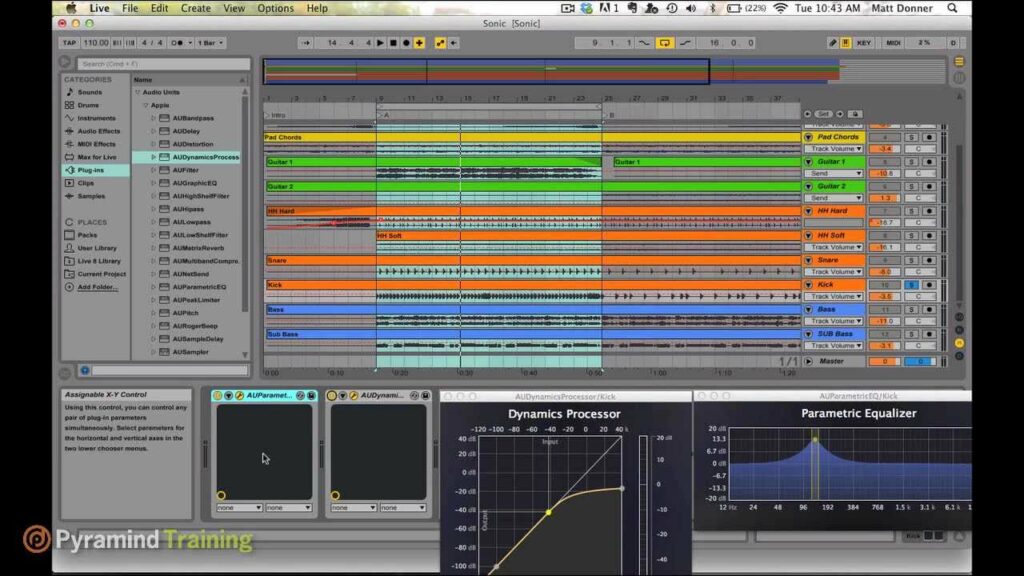Mastering the Art of Audio Alchemy: A Comprehensive Guide to Mixing Tracks in Ableton Live

Mixing tracks in Ableton Live is a delicate and intricate process that involves balancing, shaping, and sculpting individual elements to create a cohesive and compelling sonic landscape. Whether you’re blending drums, bass, vocals, and synths into a seamless whole or polishing the final mixdown of your track, mastering the art of mixing opens up a world of creative possibilities. In this extensive guide, we’ll explore every facet of mixing tracks in Ableton Live, from setting up your session to applying advanced processing techniques, empowering you to achieve professional-quality mixes that stand out in any context.
Understanding Mixing:
Before we delve into the specifics of mixing tracks in Ableton Live, let’s establish a foundational understanding of what mixing is and why it’s important:
- What is Mixing? Mixing is the process of combining and balancing individual audio tracks or stems to create a cohesive and balanced mix. It involves adjusting levels, panning, EQ, dynamics, and spatial effects to enhance clarity, depth, and impact.
- The Importance of Mixing: Mixing plays a crucial role in the production process, as it determines the overall sound and quality of a recording. A well-mixed track will have clarity, definition, and balance, allowing each element to shine while contributing to the overall impact and emotion of the music.
- Goals of Mixing: The primary goals of mixing are to achieve clarity, balance, and cohesion in the mix. This involves ensuring that each element is audible and well-defined, that the frequency spectrum is balanced, and that the spatial imaging is immersive and engaging.
Getting Started with Mixing:
Now that we have a solid understanding of mixing, let’s explore how to get started with mixing tracks in Ableton Live:
- Setting Up Your Session:
- Begin by organizing your tracks in Ableton Live’s Session or Arrangement View. Group similar tracks together (e.g., drums, bass, synths, vocals) to facilitate efficient mixing and processing.
- Assign each track to a specific mixer channel and configure the routing and signal flow as needed.
- Adjusting Levels and Panning:
- Start by adjusting the levels of each track to achieve a balanced mix. Use the faders in Ableton Live’s mixer to adjust the volume of each track relative to the others.
- Experiment with panning to create spatial separation and width in the mix. Pan individual tracks left or right to position them within the stereo field and create a sense of space and dimension.
- Applying Basic Processing:
- Use basic processing tools such as EQ and dynamics processing to shape the tone and dynamics of each track. Apply high-pass and low-pass filters to remove unwanted frequencies, and use compression to control dynamics and add punch and clarity.
Advanced Techniques and Workflow Tips:
Now that we’ve covered the basics of mixing in Ableton Live, let’s explore some advanced techniques and workflow tips to enhance your productivity and creativity:
- Bus Processing and Parallel Compression:
- Utilize bus processing techniques to apply effects and processing to multiple tracks simultaneously. Group related tracks together and apply EQ, compression, and other effects to the group bus to create cohesion and consistency in the mix.
- Experiment with parallel compression to add weight, punch, and density to individual tracks or groups of tracks. Duplicate the track or bus, apply heavy compression to the duplicate signal, and blend it with the original signal to achieve the desired balance.
- Automation and Dynamic Mixing:
- Use automation to create dynamic and expressive mixes that evolve and change over time. Automate parameters such as volume, panning, and effect sends to create movement, tension, and excitement in the mix.
- Experiment with dynamic mixing techniques such as sidechain compression, ducking, and volume rides to create space and clarity in the mix. Use sidechain compression to carve out space for the kick drum in the mix, or use volume rides to emphasize important elements during key moments in the arrangement.
- Creative Effects and Sound Design:
- Explore creative effects and sound design techniques to add depth, texture, and character to your mixes. Experiment with delay, reverb, modulation, and distortion to create unique sonic textures and atmospheres.
- Use effects such as tape emulation, saturation, and harmonic exciters to add warmth, richness, and analog character to your mix. Experiment with blending multiple effects together to create custom processing chains and signature sounds.
Integrating Mixing into Your Workflow:
As you become more comfortable with mixing in Ableton Live, consider integrating it into your overall music production workflow in the following ways:
- Continuous Improvement and Iteration:
- Approach mixing as an iterative process of continuous improvement. Regularly revisit and revise your mixes, making adjustments and refinements based on feedback and your evolving creative vision.
- Experiment with different mixing techniques, workflows, and approaches to discover what works best for you and your music.
- Collaboration and Feedback:
- Seek out feedback and collaboration with other musicians, producers, and engineers to gain new perspectives and insights into your mixes. Share your work-in-progress mixes with trusted peers and mentors, and be open to constructive criticism and suggestions for improvement.
- Collaborate with other artists and producers on mixing projects, exchanging ideas, techniques, and feedback to enhance the quality and creativity of your mixes.
- Continued Learning and Growth:
- Commit to lifelong learning and growth as a mixer and producer. Stay up-to-date with the latest trends, techniques, and technologies in mixing and audio production, and invest time and effort into developing your skills and knowledge.
- Take advantage of online tutorials, courses, workshops, and forums to expand your understanding of mixing theory, techniques, and best practices. Experiment with new tools, plugins, and workflows to push the boundaries of your creativity and achieve new levels of sonic excellence.
Conclusion:
Mixing tracks in Ableton Live is both an art and a science, requiring technical expertise, creative vision, and a keen ear for detail. By mastering its features, techniques, and workflow, you’ll unlock a world of creative possibilities for music production, sound design, and artistic expression.
Whether you’re blending drums, bass, vocals, and synths into a seamless whole or polishing the final mixdown of your track, mixing in Ableton Live provides the tools and flexibility needed to bring your sonic visions to life with precision and flair. So, dive in, experiment, and let the boundless creativity of mixing inspire your musical journey in Ableton Live!







